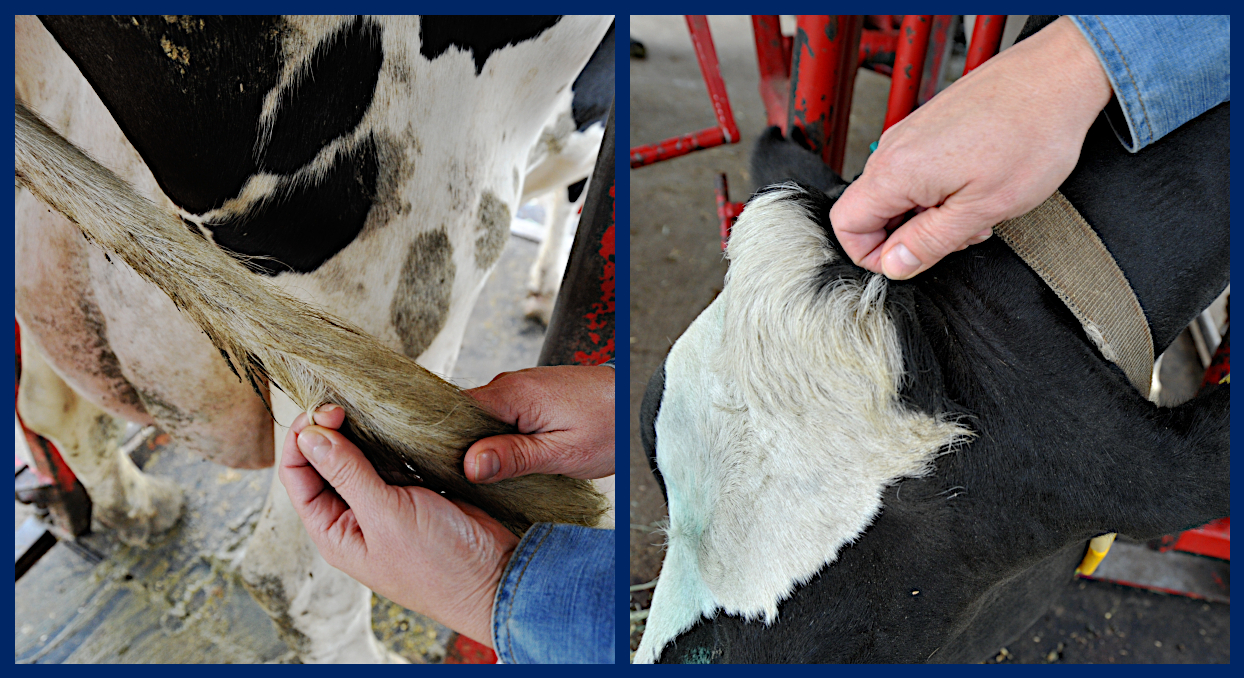Quick Summary
Click here for Price and Turnaround Time
Phenotype: Progressive ataxia (PA) of Charolais cattle is characterized by onset of unsteady gait and stiff hind limbs with gradual worsening of the condition that results in an inability to stand and permanent recumbency (lying down). Other signs of the disease include head bobbing when excited and, in females, irregular pulsatile urination. Onset of the disease is typically around 18 months of age but can occur as early as 6 months or as late as 3-5 years. The evolution of the disease is also variable from a few weeks to more than 18 months from onset of signs.
Mode of Inheritance: Autosomal recessive
Alleles: N = Normal/Unaffected, PA = Progressive ataxia
Breeds appropriate for testing: Charolais, Charolais crosses, Blonde d’Aquitaine
Explanation of Results:
- Cattle with N/N genotype will not have this progressive ataxia and cannot transmit this progressive ataxia variant to their offspring.
- Cattle with N/PA genotype will not be affected by this progressive ataxia, but are carriers. They will transmit this progressive ataxia variant to 50% of their offspring. Matings between two carriers result in a 25% chance of producing a calf with this progressive ataxia.
- Cattle with PA/PA genotype will have this progressive ataxia, a neurodegenerative disease, and will transmit this progressive ataxia variant to all of their offspring.
Sample Collection
Most of the cattle DNA tests offered by the VGL are carried out using cells from the roots of a hair sample (roughly 20-40 hairs).
Hair samples should be taken from the switch of the tail, the poll, or the neck.

1. Clean (use comb if possible) tail switch, poll, or neck by removing all loose hair and foreign matter.
2. Use fingers or pliers to grasp approximately 8-10 hairs close to the skin and pull. Pull (do NOT cut) hair strands. Examine the end of hair strands for presence of root bulbs. Hair roots are necessary for DNA testing. If the majority of hair strands lack the root bulbs, discard hair and start again.
3. Repeat until you have approximately 20-40 hairs with root follicles attached.
4. Place the 20-40 hairs with root follicles attached in the envelope and seal with the animal’s ID written on the envelope. If hairs are long they can be taped to the submission form. Do not tape the roots.

5. Repeat steps 1-4 for each additional animal being sampled.
Note:
- Hair should be dry.
- If hair has excess dirt and debris, please brush out if possible before pulling hairs for sample.
- Do not cut the hair! The roots contain the DNA for testing.
- When sampling several animals in the same session, make sure that there are no hair strands in your hands to reduce the possibility of sample contamination. Clean hands and/or pliers if possible.
Progressive ataxia (PA) of Charolais cattle is an inherited neurodegenerative disease of the central nervous system. It is caused by abnormal development of the myelin sheath that supports and insulates axons of nerve fibers in specific parts of the brain and spinal cord. PA is characterized by onset of unsteady gait and stiff hind limbs with gradual worsening of the condition that results in an inability to stand and permanent recumbency (lying down). Animals have to be euthanized as there is no effective treatment for this condition. Other signs of the disease include head bobbing when excited and, in females, irregular pulsatile urination. Onset of the disease is typically around 18 months of age but can occur as early as 6 months or as late as 3-5 years. The evolution of the disease is also variable from a few weeks to more than 18 months from onset of signs.
A single base substitution (c.608G>A) in exon 5 of KIF1C gene has been identified as a causal variant for PA in the Charolais breed. This substitution modifies a conserved amino acid (p.Arg203Gln) resulting in a mutated protein. In addition, because of the location of this mutation at the end of exon 5, this variant also causes alternative splicing of this gene that skips exon 5 and produces a truncated (shorter) protein. The overall combined effect of the mutation is the absence of KIF1C protein in the brain.
PA is inherited in an autosomal recessive fashion, which means that both males and females are affected and that 2 copies of the defective gene are needed for presentation of the disease. Frequency of PA mutation in the Charolais breed has been recently estimated to be about 13%. In a sample of 3,300 French commercial Charolais cattle screened for the mutation, the incidence of affected animals was around 1.1% among animals aged 7 and just below 1% at 24 months old, with no affected, homozygous animals observed at 30 months of age. The prevalence of the mutation and disease in the Charolais breed result from a popular sire effect tracing to a carrier bull, born in 1964, that had high contribution to the breed, and to a hitch-hiking effect from close proximity of the PA mutation to a genomic region under positive selection for muscular development and weight gain. A very low frequency (less than 0.1%) of the PA mutation has also been found in Blonde d’Aquitaine cattle, which have Charolais influence.
Testing for PA in Charolais, Charolais-crossbreds, and Blonde d’Aquitaine cattle helps breeders determine if carriers are present among breeding stock and use mating strategies to avoid producing affected calves. Carriers can be safely bred to N/N mates, as this type of breeding will not produce affected calves. Genetic testing also helps veterinarians to confirm diagnosis of progressive ataxia in animals exhibiting signs of the disease.
Other neurodegenerative defects occur in Charolais cattle that are not caused by the PA mutation, but their etiology is unknown.
